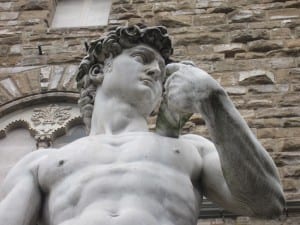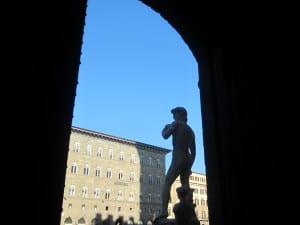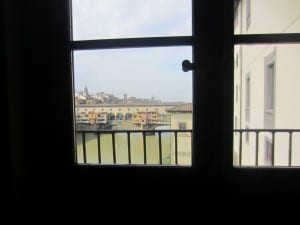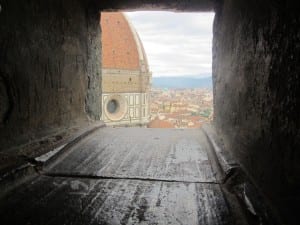I thought Italy didn’t get better than Venice or Rome but I was wrong. Florence tops them. Anyone with a passion for art and history will feel at home walking in the footsteps of Donatello, Leonardo, Michelangelo. Galileo, Rossini, Brunelleschi worked there. The piazzas are unchanged. The same church bells ring the hours and call for mass. Cobblestones are original. If ever you wanted to kiss the ground, go to Florence where the essence of the renaissance spirit is alive and well. Although the practice of attribution makes me nervous, I risk suggesting people unaffected by Florence have no soul.
The 19th century author Stendhal, pseudonym of Henri-Marie Beyle,wrote the travelogue ‘Naples and Florence: A Journey from Milan to Reggio’ in 1817. Stendhal described his emotional reaction following a visit to Santa Croce, where highlights include frescos by Gaddi and Giotti dating from the early 1300’s. The frescos did it for Henrie-Marie. I was in a sort of ecstasy, from the idea of being in Florence, close to the great men whose tombs I had seen. Absorbed in the contemplation of sublime beauty… I reached the point where one encounters celestial sensations… Everything spoke so vividly to my soul…I had palpitations of the heart..Life was drained from me. I walked with the fear of falling. In the 1970s, Dr. Graziella Magherini at the Santa Maria Novella hospital, observed tourists overcome with physical and cognitive responses to the Florentine experience and named this Stendhal’s syndrome.
I didn’t suffer SS but did contract my own version. Now known as Florence Face, FF is to be open mouthed while lost for words. It was sensory overload. Accustomed to a world of digital simulations, which can dilute the impact of a ‘first-time’ experience, standing in the Uffizzi, inches from Botticelli’s Venus, or seeing Michelangelo’s David in the Academia, were useful reminders of the power of authentic objects. Iconic imagery fails to capture the essence of the original. The Other is not the same as the Real. For someone who lives too much life online, where anything is available in digital format, being in Florence was to experience the impact of reality.
The virtual experience of teaching and learning can never be the same as a one-to-one tutorial or small group seminar. We have to accept the limitations. The rhetoric of the 1990’s was over ambitious and doomed to disappoint. Technology can’t smile but has definite advantages. Content can be accurately repeated. It doesn’t get tired. Links open new doors. Make unexpected connections. Reflective journals can be as comprehensive as necessary while remaining private. Cut/copy/paste commands make it easy to edit. Tools like blogs, wikis and discussion forums support online discussion and collaboration. Online assessment is neat and tidy. Online feedback legible. 24/7 access across traditional boundaries of time and distance widens participation. There are lots of positives to offset the downsides of mechanisation. While the virtual can never have the impact of the real, this doesn’t mean we should dismiss it. I still have my photographs and postcards of Florence. They are permanent reminders of what can only ever be a transitory experience.



